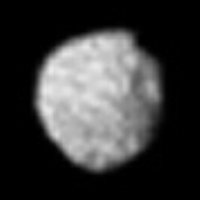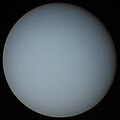天卫十五
 | |
| 发现 | |
|---|---|
| 发现者 | Stephen P. Synnott / 航海家2号 |
| 发现日期 | 1985年12月30日 |
| 编号 | |
| 形容词 | 波克的 |
| 轨道参数 | |
| 二次轨道半径 | 86,004.444 ± 0.064 km[1] |
| 离心率 | 0.00012 ± 0.000061[1] |
| 轨道周期 | 0.76183287 ± 0.000000014 d[1] |
| 轨道倾角 | 0.31921 ± 0.021° (相对于天王星的赤道)[1] |
| 隶属天体 | 天王星 |
| 物理特征 | |
| 平均半径 | 81 ± 2 km[2] |
| 表面积 | ~82,400 km²[3] |
| 体积 | ~2,225,000 km³[3] |
| 质量 | ~2.9 × 1018 kg[3] |
| 平均密度 | ~1.3 g/cm³ (假设) |
| 表面重力 | 0.028 m/s2[3] |
| 0.069 km/s [3] | |
| 自转周期 | synchronous[2] |
| 转轴倾角 | zero[2] |
| 反照率 | 0.11 ± 0.015 (geometric) 0.035 ± 0.006 (bond) at 0.55 μm[4] |
| 温度 | ~64 K[3] |
| 视星等 | 20.5 [5] |
天卫十五 (波克,Puck) (发音: /ˈpʌk/ puk) 是于1985年12月被航海家2号[6]太空船发现的天王星内卫星,名称来自凯尔泰神话和英语的民间传说[可疑]。天卫十五位于天王星环和大卫星米兰达之间,是一颗直径大约162公里,形状接近球形的天体[2]。他的表面有一个大且黑暗的坑穴,其中的光谱呈现水冰的迹象[7]。
发现和命名
[编辑]天卫十五-天王星最大的内侧行星-是从1985年12月30日的 航海家2号 影像中发现的,他被赋予的临时名称是S/1985 U1[8]。
稍后,这颗卫星被以出现在莎士比亚的仲夏夜之梦中,可以在一夜之间和仙女游遍全球的小精灵。在凯尔特神话和英语的民间传说,波克是淘气的精灵,基督徒将之想像为恶魔。
它也被命名为天卫十五[9]。
物理性质
[编辑]天卫十五是天王星最大的小内卫星,它的轨道位于米兰达 (天卫五) 的内侧。他的大小介于波提亚 (第二大的内侧卫星) 和 米兰达 (五大卫星中最小的)之间,是中等大小的卫星。天卫十五的轨道介于天王星环和天卫五之间,除了轨道之外,我们对它的了解很少[1],半径大约是81公里[2],此外在可见光的几何反照率大约是0.11[4]。
航海家2号的影像团对所发现的卫星,只有天卫十五是很早就发现的,因此可以就探测器的程式进行设计,以获得一些较详细的影像[6]。影像显示天卫十五的形状是略为椭的球体 (轴的比率是0.97±0.04)[2],表面有个巨大的坑[5]和颜色是灰色的[2]。表面有三个陨石坑已经被命名,最大的直径大约45公里[6]。哈伯太空望远镜和大地机望远镜的观测发现天卫十五的光谱有水冰的吸收谱线特征[4][7]。 对天卫十五的内部结构一无所知。它可能是由类似于环中发现的黑暗物质与水冰组合成的混合物[7]。这些黑暗的物质可能是岩石或有机的辐射过程造成的。缺乏有着明亮辐射线的坑穴,暗示冰和非冰的成分彼此没有分离形成核心和地幔[6]。
相关条目
[编辑]参考资料
[编辑]- ^ 1.0 1.1 1.2 1.3 1.4 Jacobson, R.A. The Orbits of the Inner Uranian Satellites From Hubble Space Telescope and Voyager 2 Observations. The Astronomical Journal. 1998, 115 (3): 1195–1199. Bibcode:1998AJ....115.1195J. doi:10.1086/300263.
- ^ 2.0 2.1 2.2 2.3 2.4 2.5 2.6 Karkoschka, Erich. Voyager's Eleventh Discovery of a Satellite of Uranus and Photometry and the First Size Measurements of Nine Satellites. Icarus. 2001, 151 (1): 69–77. Bibcode:2001Icar..151...69K. doi:10.1006/icar.2001.6597.
- ^ 3.0 3.1 3.2 3.3 3.4 3.5 Calculated on the basis of other parameters
- ^ 4.0 4.1 4.2 Karkoschka, Erich. Comprehensive Photometry of the Rings and 16 Satellites of Uranus with the Hubble Space Telescope. Icarus. 2001, 151 (1): 51–68. Bibcode:2001Icar..151...51K. doi:10.1006/icar.2001.6596.
- ^ 5.0 5.1 Thomas, P.; Veverka, J.; Johnson, T.V.; et al.. Voyager observations of 1985U1. Icarus. 1987, 72 (1): 79–83. Bibcode:1987Icar...72...79T. doi:10.1016/0019-1035(87)90121-7.
- ^ 6.0 6.1 6.2 6.3 Smith, B.A.; Soderblom, L.A.; Beebe, A. et al.. Voyager 2 in the Uranian System: Imaging Science Results. Science. 1986, 233 (4759): 97–102. Bibcode:1986Sci...233...43S. PMID 17812889. doi:10.1126/science.233.4759.43.
- ^ 7.0 7.1 7.2 Dumas, Christophe; Smith, Bradford A.; and Terrile, Richard J. Hubble Space Telescope NICMOS Multiband Photometry of Proteus and Puck. The Astronomical Journal. 2003, 126 (2): 1080–1085. Bibcode:2003AJ....126.1080D. doi:10.1086/375909.
- ^ Smith, B.; Hansen, C. IAU Circular No. 4159. International Astronomical Union. January 16, 1986 [2006-08-06]. [永久失效链接]
- ^ Planet and Satellite Names and Discoverers. Gazetteer of Planetary Nomenclature. USGS Astrogeology. July 21, 2006 [2006-08-06]. (原始内容存档于2009-08-25).
外部链接
[编辑]- Puck Profileby NASA's Solar System Exploration(页面存档备份,存于互联网档案馆)
- Page that includes a reprocessed version of the Voyager Puck image
| ||||||||||||||
| |||||||||||||||||||||||||||
| ||||||||||||||||||||||||||||||||||||||||||
| ||||||||||||||||||||||||||||||
Text is available under the CC BY-SA 4.0 license; additional terms may apply.
Images, videos and audio are available under their respective licenses.




